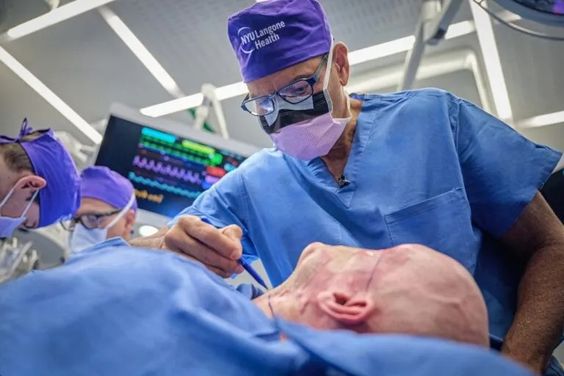Health
Surgeons have successfully performed the world’s first complete eye transplant, marking a significant milestone in medical history

Although it’s unclear if the patient will truly regain his sight, a team of surgeons in New York claimed on Thursday that they had carried out the first-ever whole eye transplant, a technique that is largely regarded as a medical first.
In June 2021, a line worker from Arkansas received a 7,200-volt electric shock when his face came into contact with a live wire. To preserve his face and his left eye, a donor’s parts were removed during the revolutionary surgery.
In addition to losing his dominant left arm above the elbow, nose, lips, front teeth, left cheek area, and chin, Aaron James, 46, sustained numerous other injuries.
He was directed to one of the best medical facilities for face transplants, NYU Langone Health, which performed the surgery on May 27.
Long regarded as the ultimate medical goal, whole eye transplantation has never been carried out on a living individual, despite some success in mice where doctors were able to restore partial eyesight.
The 21-hour procedure, conducted by Eduardo Rodriguez, used 3D cutting guides to enable surgeons to accurately extract and implant bone fragments from the donor into James. “We always talk about a second chance at life—he’s been given a second chance,” Rodriguez said.
He continued, complimenting James for having the exceedingly risky procedure in order to help future patients in similar circumstances. “We couldn’t have asked for a more perfect patient,” he said.
Retinal opthamologist Vaidehi Dedania reported that the left transplanted eye seems to be doing quite well. James can’t see yet, but it’s getting enough blood, holding its blood pressure, and sending out an electrical signal. However, she continued, “we have a lot of hope.”
“Big deal.” – Kia Washington, a 15-year veteran of the University of Colorado Anschutz Medical Campus as a professor of surgery, told AFP that her colleagues’ accomplishments were “huge deals.”
READ ALSO: Boniface creates history as Bayer Leverkusen defeats Cologne in the Bundesliga
“The transplantation of a human eye at NYU Langone represents a pivotal moment in our common quest to restore sight and offers hope to countless individuals around the world,” said Daniel Pelaez of the Bascom Palmer Eye Institute at the University of Miami, who has also been working towards the same goal.
Because James needs a facial transplant and would need immunosuppressive medications otherwise, the risk-benefit analysis made him an excellent candidate, even if the procedure would merely be cosmetic. James’ right eye is still intact.
James thanked the donor’s family as well as his medical team profusely during a press conference. “I believe we overcame it; it was a test of strength, determination, family, and friends,” he remarked.
Although James goes back to New York every month for follow-up appointments, he returned to his home state of Arkansas in September to spend time with his wife and kid.
Optic nerve regeneration: Regaining vision in James’s eye would be unlikely given the amount of time that has elapsed since the surgery, but Washington cautioned, “I never say something is impossible.”
Adult stem cells generated from bone marrow were employed, according to the NYU Langone researchers, to support nerve healing.
Other cutting-edge techniques, such as gene therapy to harness the optic nerve’s innate capacity for healing, the use of nerve wraps to protect tissue, or the use of devices that pick up signals and avoid the damaged pathway, may be necessary to achieve the goal of sight restoration, according to Washington.
Leading similar work at Stanford University’s Byers Eye Institute, Jeffrey Goldberg told AFP that “we’re making great progress in the treatments to promote optic nerve regeneration that could accompany eye transplant.”
AFP
